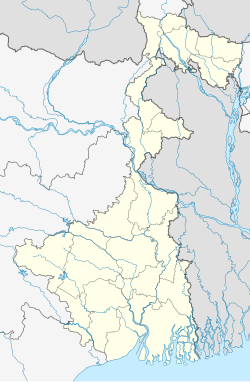Gitaldaha is a village and a gram panchayat in the Dinhata I CD block in the Dinhata subdivision of the Cooch Behar district in the state of West Bengal, India.
Gitaldaha | |
|---|---|
Village | |
Location in West Bengal | |
| Coordinates: 26°01′55″N 89°29′02″E / 26.032°N 89.484°E | |
| Country | |
| State | West Bengal |
| District | Cooch Behar |
| Population (2011) | |
| • Total | 2,058 |
| Time zone | UTC+5:30 (IST) |
| PIN | 736135 |
| Telephone/STD code | 03582 |
| Vehicle registration | WB |
| Lok Sabha constituency | Cooch Behar |
| Vidhan Sabha constituency | Sitai |
| Website | coochbehar |
Geography
edit5miles
temple
Pratham
Khanda
CT: census town, M: municipal town, R: rural/ urban centre, H: historical/ religious centre
Owing to space constraints in the small map, the actual locations in a larger map may vary slightly
Location
editGitaldaha is located at 26°01′55″N 89°29′02″E / 26.032°N 89.484°E.
Gitaldaha I and Gitaldaha II are gram panchayats in Dinhata I CD block.[1]
Area overview
editThe map alongside shows the eastern part of the district. In Tufanganj subdivision 6.97% of the population lives in the urban areas and 93.02% lives in the rural areas. In Dinhata subdivision 5.98% of the population lives in the urban areas and 94.02% lives in the urban areas.[2] The entire district forms the flat alluvial flood plains of mighty rivers.[3]
Note: The map alongside presents some of the notable locations in the subdivisions. All places marked in the map are linked in the larger full screen map.
Demographics
editAs per the 2011 Census of India, Gitaldaha had a total population of 3,917. There were 2,058 (53%) males and 1,859 (47%) females. There were 492 persons in the age range of 0 to 6 years. The total number of literate people in Gitaldaha was 2,563 (74.83% of the population over 6 years).[4]
Railway connections
editNew Gitaldaha railway station is on the broad gauge Alipurduar-Bamanhat branch line. Local trains link the area to larger stations at Cooch Behar and Alipurduar from where trains are available for places all over the country.[5]
The area was agog with railway activity in the 19th-20th century. The Assam Behar State Railway linked Parbatipur to Katihar, with a metre gauge line in 1889. in the early 1900s, the Eastern Bengal Railway extended railways to Lalmonirhat, Gitaldaha (via Mogalhat), Bamanhat, Golokganj and other places, thereby connecting Assam to Katihar, in Bihar, via North Bengal. In 1901 Cooch Behar State Railway built the narrow gauge line from Gitaldaha to Jayanti, near the Bhutan border. Shortly thereafter, the line was upgraded to meter gauge.[6][7]
The Lalmonirhat-Mogalhat-Gitaldaha route was functional when India and Pakistan agreed in 1955 for resumption of railway traffic between the two countries, and it included movement of cross traffic via Mogalhat through the Eastern Bengal Railway.[8] A portion of the bridge across the Dharla River at 26°00′11″N 89°28′10″E / 26.00304°N 89.46934°E was washed away by floods in 1988.[9][10]
The conversion of the 72 km (45 mi) long Alipurduar-Bamanhat branch line to 1,676 mm (5 ft 6 in) 5 ft 6 in (1,676 mm) broad gauge in 2007, and its subsequent recommissioning, had a station at New Gitaldaha.[11]
References
edit- ^ "Directory of District, Subdivision, Panchayat Samiti/ Block and Gram Panchayats in West Bengal". Cooch Behar. Retrieved 31 July 2020.
- ^ "District Statistical Handbook 2013 Cooch Behar". Tables 2.2, 2.4b. Department of Planning and Statistics, Government of West Bengal. Archived from the original on 21 January 2019. Retrieved 5 August 2020.
- ^ "District Census Handbook, Koch Bihar, Series 20, Part XIIA" (PDF). Census of India 2011, pages 17-21 Physical feafures. Directorate of Census Operations, West Bengal. Retrieved 5 August 2020.
- ^ "C.D. Block Wise Primary Census Abstract Data(PCA)". West Bengal – District-wise CD Blocks. Registrar General and Census Commissioner, India. Retrieved 31 July 2020.
- ^ "55765 =>55465 Alipurduar – Bamunhat Passenger". Time Table. Indiarailinfo. Retrieved 31 July 2020.
- ^ R.P. Saxena. "Indian Railway History timeline". Archived from the original on 14 July 2012. Retrieved 31 July 2020.
- ^ "Royal History". page 5. Cooch Behar district authorities. Retrieved 31 July 2020.
- ^ "Agreement on Resumption of Rail Traffic, 15 April 1955". Media Center, Ministry of External Affairs, Government of India. Retrieved 31 July 2020.
- ^ "A Snap in the Link". Jebun Nesa Alo. The Business Standard, 22 February 2020. Retrieved 31 July 2020.
- ^ "Villages without borders". Suvojit Bagchi. The Hindu, 24 June 2017. Retrieved 31 July 2020.
- ^ Srivastava, V.P. "Role of Engineering Deptt in Meeting Corporate Objectives of Indian Railways" (PDF). Archived from the original (PDF) on 30 March 2014. Retrieved 31 July 2020.

